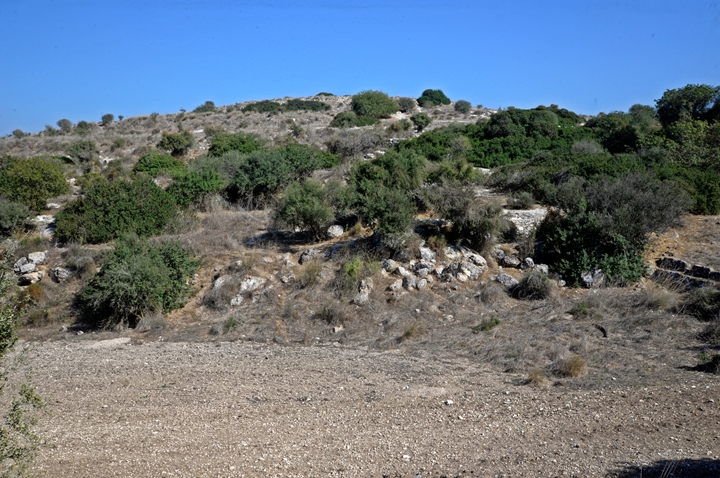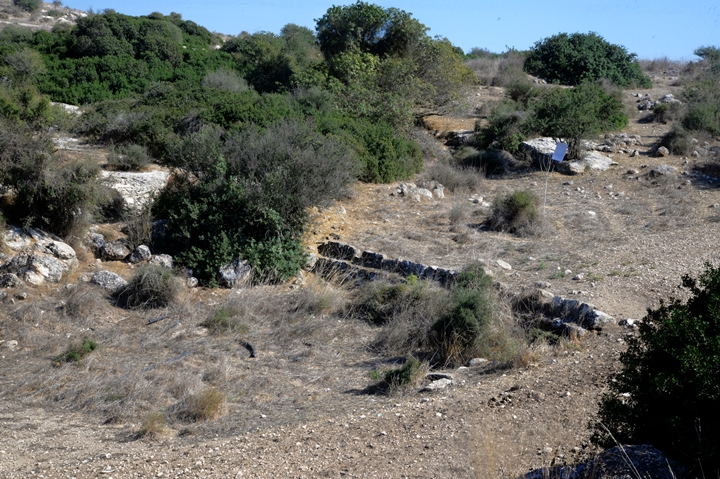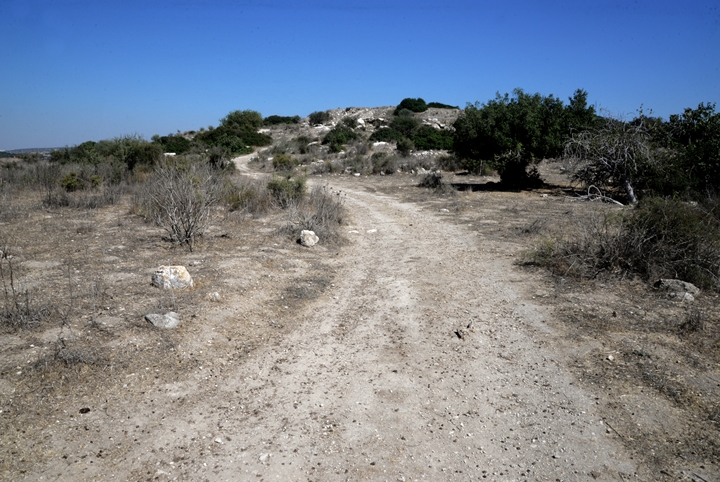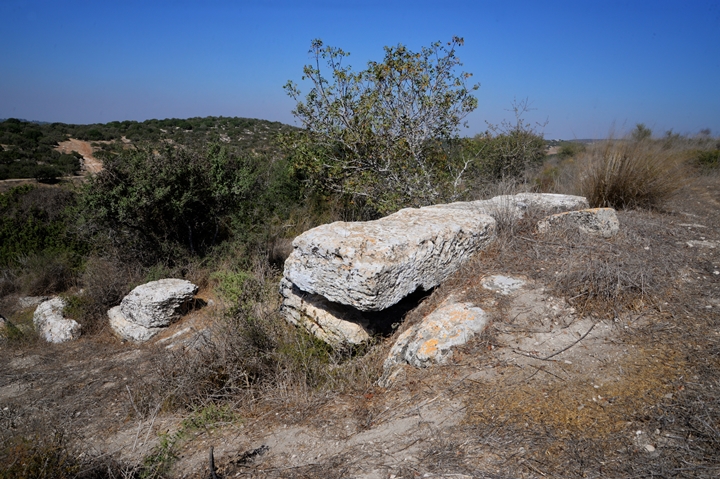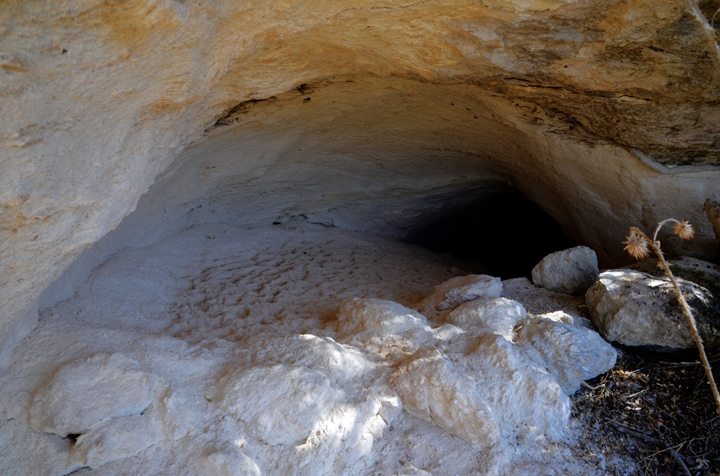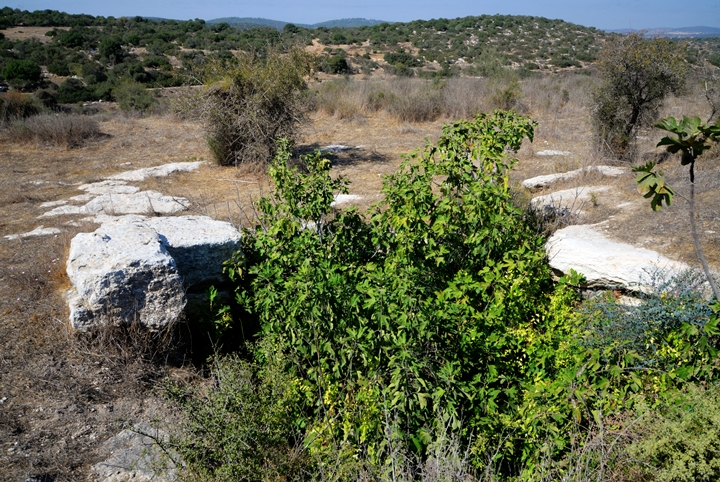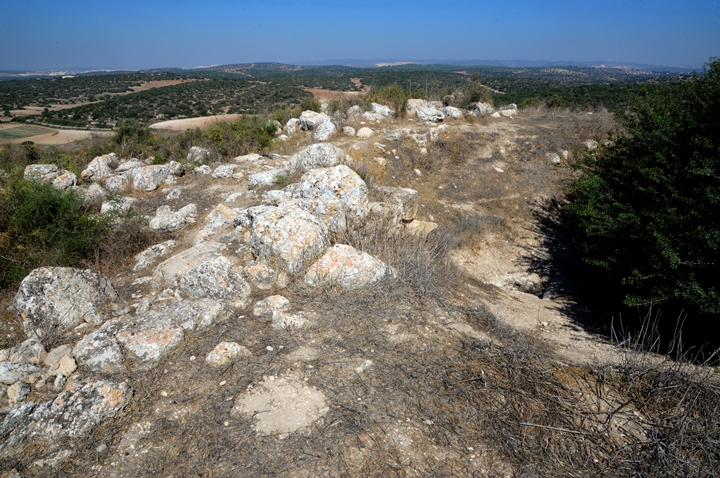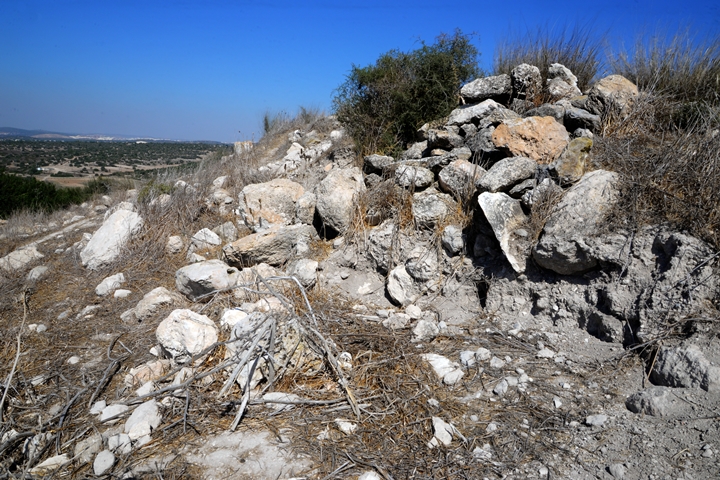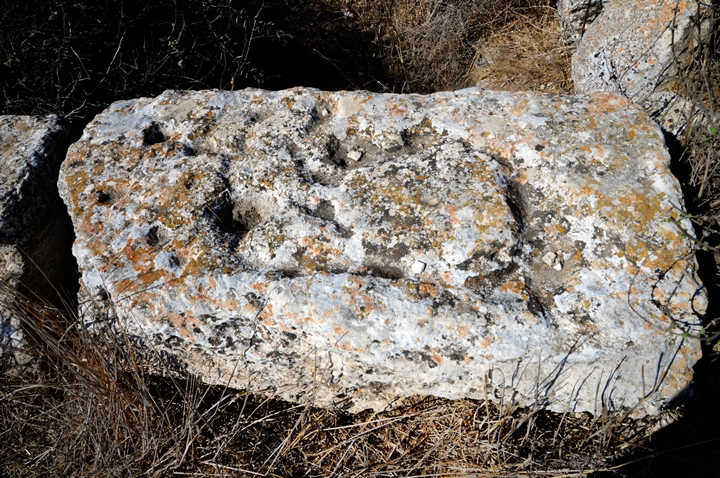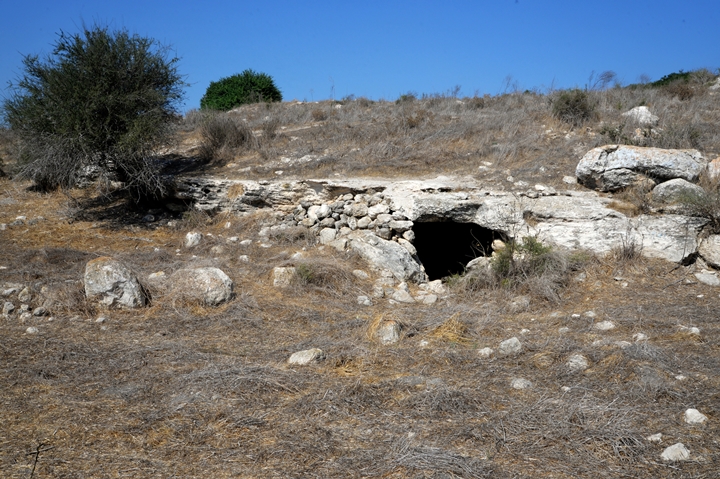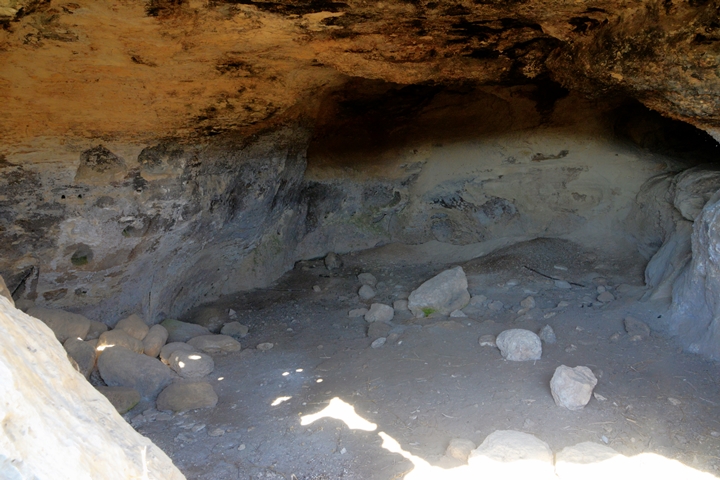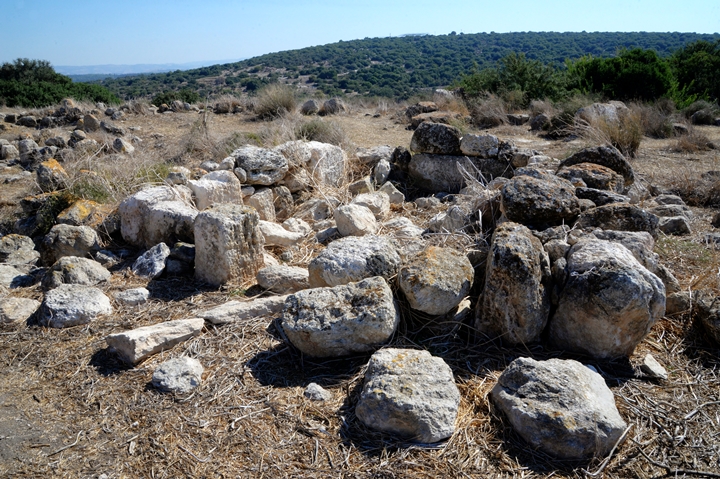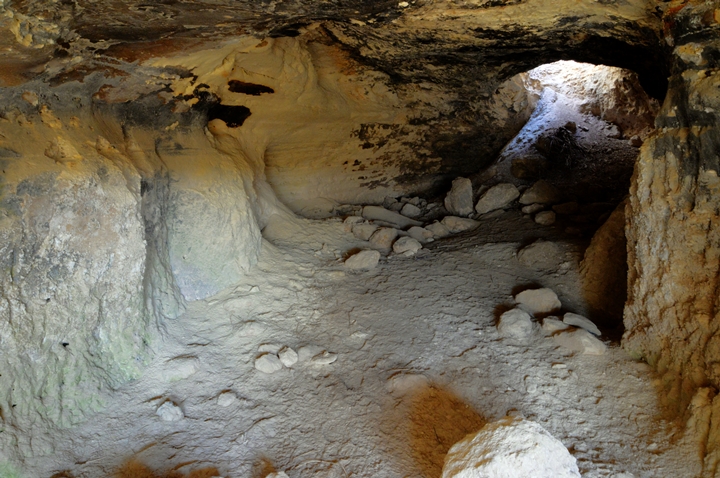Ruins of an Iron Age, Early-Roman and Byzantine village in the Judean foothills region, south of the valley of Elah.
Home > Sites > Judea > Park Adullam > Horvat Lavnin
Contents:
Overview
Location
History
Photos
* Aerial views
* Western side
* Burial caves
* Summit
* Eastern side
* Southern side
* Video
Etymology
Links
Overview:
Horvat Lavnin (Khirbet Tell el-Beida) – “The ruin of the white mound”) is located in the Adullam -France National park, situated on a hill above the western bank of Nahal Hakhlil. This area, south of the valley of Elah, has fertile lands with broad valleys, and was in ancient times a highly populated farming area.
On the mound are traces of fortifications, building walls, installations, columbarium, burial caves, cisterns and a carved lintel.
Location:
The following aerial view shows the area of the ruins. The site is situated on a hill at an altitude of 395m, 70m above the stream (Nahal Hakhlil) on the north side.
Access to the site is from Highway #38 from a park road that starts near Moshav Tsafririm. Follow signs to Horvat Midras, but pass the turn to Midras, continuing 1.5km until a turn north to the site.

History:
- Biblical period
According to ceramics survey, installations and caves, the site was founded during the Late Bronze age, and was settled during the Iron Age, the second Temple period and the Byzantine period. Hiding complexes of the Bar-Kochbah revolt and a ritual bath (Miqveh) indicate that it was a Jewish village.
The village may be identified as Biblical Achzib of Judah (Joshua 15:44): “…and Keilah, and Achzib, and Mareshah”.
An alternative identification was suggested as Biblical Libnah, although that city is widely accepted as being in Tel Burna. (Joshua 15:42): “Libnah, and Ether, and Ashan”. There are, however, other possible identifications.
A map of the cities and roads of the Iron Age period is here, with Aczib (Achzib) marked as a red point in the center, south west of Adullam and south of the valley of Elah.
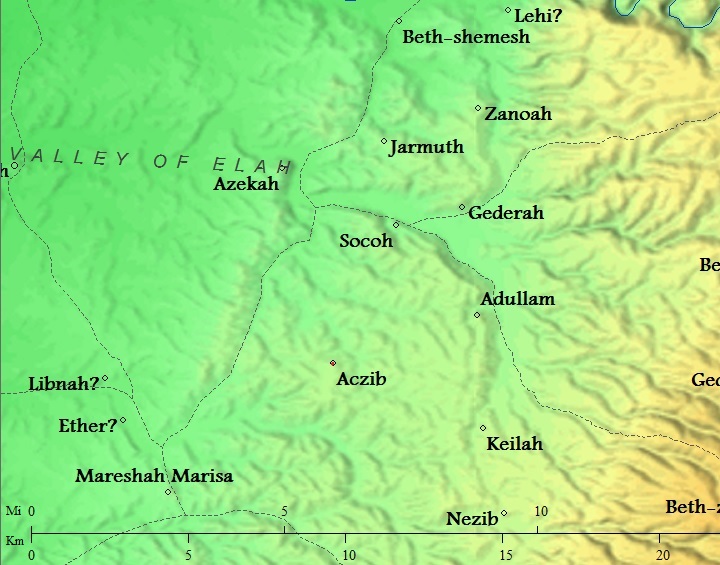
Cities and roads around Lavnin (Aczib?) – during the Canaanite, Israelite periods up to the Hellenistic period – Bible Mapper 3.0
- Roman period
During the great revolt against the Romans the village was probably burnt and destroyed. A record of such destruction may have been implied in Josephus accords, when the nearby Jewish village (Ethri = Caphethhra) was destroyed by the 5th Legion in 69 AD (War IV:9:9):
“…but Cerealis, one of his commanders, took a body of horsemen and footmen, and laid waste that part of Idumea which was called the Upper Idumea, and attacked Caphethra, which pretended to be a small city, and took it at the first onset, and burnt it down”.
- Bar Kokhba hiding complexes
During the second (Bar Kokhba) revolt in the 2nd century AD, Jewish residents across most of the villages in Judea tried to save themselves by constructing underground hiding places. The Roman historian Cassius Dius wrote about this (Historia Romania, 69, 12, 3):
“To be sure, they did not dare try conclusions with the Romans in the open field, but they occupied the advantageous positions in the country and strengthened them with mines and walls, in order that they might have places of refuge whenever they should be hard pressed, and might meet together unobserved under ground; and they pierced these subterranean passages from above at intervals to let in air and light”.
In 2020 the archaeologists mapped 4 hiding complexes dated to the Bar Kokhba revolt.
- Devastation of Judea
These hiding places may have saved some of the souls. However, the carnage that followed the onslaught left the village in ruins.
After its destruction, the Jewish population ceased, as all other Jewish villages in Judea. Cassius Dio, the historian of Rome, wrote about the devastation of Judea by Hadrian (Roman History, 69 13):
“Fifty of their most important outposts and nine hundred and eighty-five of their most famous villages were razed to the ground. Five hundred and eighty thousand men were slain in the various raids and battles, and the number of those that perished by famine, disease and fire was past finding out. Thus nearly the whole of Judaea was made desolate, a result of which the people had had forewarning before the war”.
Jews were forbidden to return to all settlements in the vicinity of Jerusalem. Eusebius of Caesarea wrote about this ban in the 4th century (Church History, Book IV, Ch. 6, 3):
“…the whole nation was prohibited from this time on by a decree, and by the commands of Hadrian, from ever going up to the country about Jerusalem. For the emperor gave orders that they should not even see from a distance the land of their fathers..”.
- Byzantine period
The settlement was renewed during the Byzantine period. An archaeological survey identified graffiti of the Byzantine period which was found in a burial cave.
- Ottoman period – PEF survey and excavations (19th Century AD)
The area around the site was examined in the Palestine Exploration Foundation (PEF) survey (1866-1877) by Wilson, Conder and Kitchener. A section of their map is shown below, with the site in the center appearing as Tell el Beida. The area around the site was heavily populated with farms and villages.
They added a short review of the site, focusing on the columbarium cave which they attributed to a burial cave with 120 “urns” (Volume III, sheet XXI, p. 369):
“Khurbet Tell el Belda (I u).—Caves, cisterns, heaps of stones, foundations. One of the caves has 120 niches (apparently for urns) in it”.
Part of Map Sheet 21 of Survey of Western Palestine, by Conder and Kitchener, 1872-1877. (Published 1880, reprinted by LifeintheHolyLand.com)
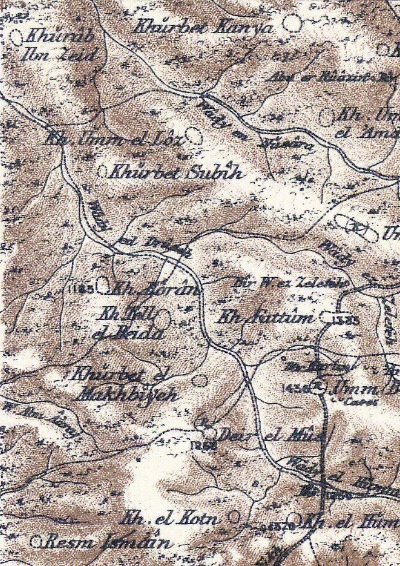
- British mandate
The IAA archives have 2 sets of British Mandate reports from the site:
- A British survey of the site (1943) did not find the heaps of stones, as indicated in the PEF report, and attributes this to a nearby lime kiln that may have been used to consume the stones.
- Another report (1936) was a letter from a citizen who reported that the site was robbed by a land owner from Bethlehem, who found “golden crosses and a silvery cup”, which he then sold. The land owner was not prosecuted.
A map published in the 1940s shows the area around the site – named Tell el Beida. The majority of the ruins are marked (as small dots) on the summit and the eastern and southeast foothills. All the caves are marked on the western side.
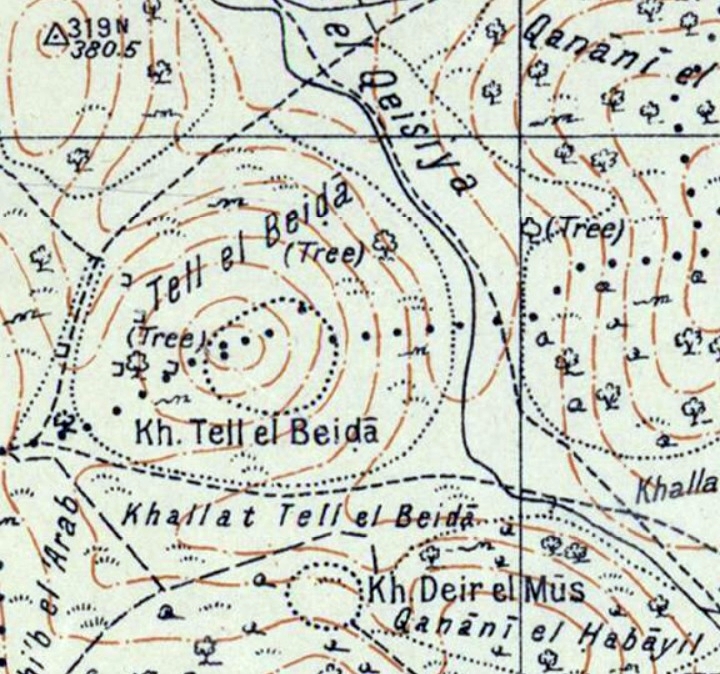
https://palopenmaps.org – Palestine 1940s 1:20,000 map
-
Modern Period
Limited surveys were conducted, focusing on the burial and hiding caves.
Today the site is part of the Adullam-France National park, and is accessible to the public.
Photos:
(a) Aerial Views
An aerial view of the site, taken above the north east side, was captured by the drone in October 2021. The mound is surrounded by fertile valleys. Its upper part is surrounded by a peripheral wall consisting of large fieldstones.
Click on the photos to view in higher resolution…
(b) Western side
Access to the site is via a narrow paved park road that climbs up from the valley of Hakhlil and ascends along the western foothills towards the south.
An ancient dam is seen along the ascent.
An access path leads from the park’s road to the western side of the mound.
(c) Burial Caves and cisterns
Most of the burial caves are cut into the rocks on the western and southern foothills.
The following photos show some of the caves. We did not enter into the caves this time.
All the burial caves have been robbed over the millenniums.
(d) Summit
A peripheral wall, consisting of large fieldstones, surrounds sections of the summit.
In several section there were signs of recent illicit diggings.
(e) Eastern side
The eastern side of the summit has the most visible architectural remains. This photo shows a view towards the north, with remains of a structure built with fine ashlar stones. This looks like a section of a corner tower.
Detailed view of one of the stones, with engraved patterns on its surface.
In another place – a threshold stone.
Another remarkable piece is a decorated lintel. The carved decorations include a jar, ribbons and rosette.
Other traces of structures are scattered along the summit and its upper foothills.
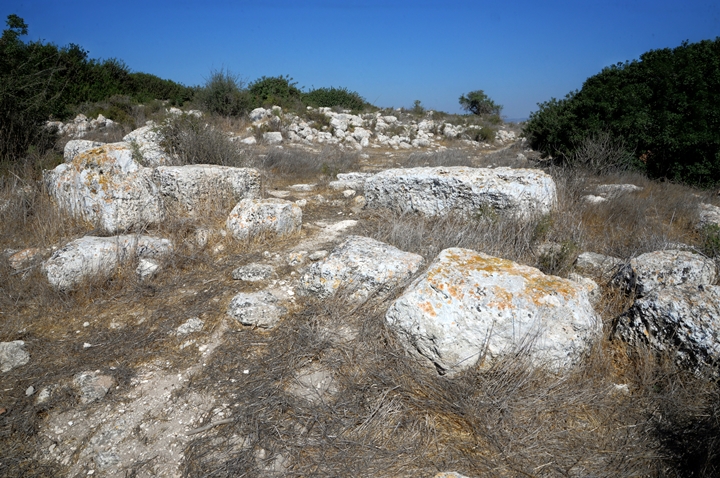
(f) South side
On the southern side are complexes that include caves, used for residence and for sheepfolds.
A view of the cave’s interior:
Remains of a structure:
Another complex on the southern foothills:
The interior of one of the caves:
(f) Video
![]() Fly over the site with this YouTube video:
Fly over the site with this YouTube video:
Etymology:
Names of the site:
- Khirbet Tell el-Beida – “The ruin of the white mound”
- Tel Lavnin – Modern Hebrew name, based on the Arab name. Tel – mound; Lavan – white.
- Khakhlil, Hachlil, Hakhlil – Reddish (term used also for red wine)
- Achziv, Achzib – Biblical name of two sites – in the Galilee and here in Judea (Joshua 15:44): “…and Keilah, and Achzib, and Mareshah”).
Links:
* Archaeology:
- Hike to Horvat Ethri (ynet, Hebrew)
- Rock-Cut Hiding Complexes from the Roman Period in Israel Boaz Zissu and Amos Kloner (2009)
- Cassius Dio, Roman History
- Boaz Zissu academic papers
- British era archives (IAA archives, under Kh. al Beida folder)
- Horvat Lavnin – Boaz Zissu, Hadashot Arkheologiyot V113 2001 pp 153-154 (http://www.jstor.org/stable/23487083)
- Horbat Labnin – Hadashot Arkheologiyot V135 2023 – Eitan Klein, Amir Ganor, Gidon Goldenberg, Ilan Hadad and Ayelet Levy-Reifer – underground survey of 4 hiding complexes conducted in 2020
* Internal – sites nearby:
* Other:
- Drone Aerial views – collection of Biblical sites from the air
- BibleWalks Youtube channel
- Achzib (Achziv) – in the Galilee
BibleWalks.com – travel with the Bible in hand
Horvat Ethri<<<—previous site–<<< All Sites >>>—>>> —Next Judea site—>>>Horvat Shua
This page was last updated on July 15, 2023 (New link, added text)
